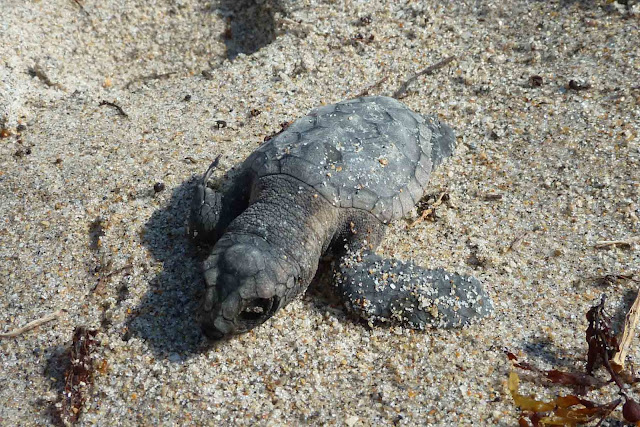Last weekend we were feeling adventurous, and so decided to check out a couple of nearby hotspots that were new to us. The first was Frenchman's Forest, where we had hoped to find abundant warblers, but came up empty. Hopefully this was a mere fluke, as, now that we've moved a little farther north than our recently departed apartment, our older, more reliable locations are quite a bit more out of the way.
Fortunately, the morning was still early enough for us to move on to John D. MacArthur Beach State Park. The prominent feature here is a long, beautiful wooden footbridge leading out to a sandy island shoreline. We expected that we might find shorebirds, but besides Willets and Sanderlings, there were none. A Yellow-crowned Night-heron was also present, strolling the border between the sand and the vegetation.
Palm Beach County is nesting site to many hundreds of Loggerhead Sea Turtles each year, along with lesser numbers of Green, Hawksbill, and Leatherbacks. We were informed by a ranger that once the eggs get wet, the incubation process is terminated. That morning, he had already rescued a couple of hatchling Loggerheads and a Hawksbills. We kept our eyes out, in case we might be able to point any in the right direction, but the only turtles we found were well past our being able to help. While some must have hatched and weren't able to find water, others failed to even make it completely out of their shell. Fortunately, another ranger that we spoke to said that most of the turtles were able to hatch before the storm came.
Worst of all, we found a Laughing Gull tossing about some would-be meal. Closer inspection revealed that it was, indeed, a sea turtle. Whether it had already been dead by the time the gull found it was impossible to tell, but it was clear to us that the turtle was beyond any help. The ruthless tossing by the gull had seen to that. Whether it would have been appropriate for us to intervene on the turtle's behalf is difficult to say, but it was certainly wasn't easy to watch helplessly as the gull struggled to get it down.















A rare look inside a turtle egg. Poor little guys. I guess mortality is always extremely high for baby turtles, but that doesn't make it easier to watch.
ReplyDeleteYeah--hard to look at, but good to know. Thanks for this eye-opening post!
ReplyDeleteYes, this was difficult to see, but fascinating at the same time. I love turtles. They're actually my first animal obsession before birds. I collect all things turtle/tortoises. It was heartbreaking, but my inner scientist/explorer was curious when this rare opportunity arose.
ReplyDelete